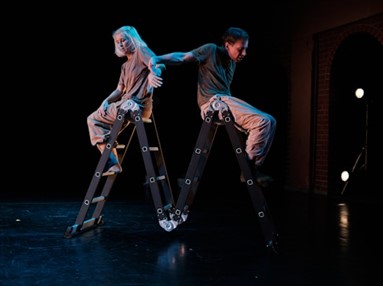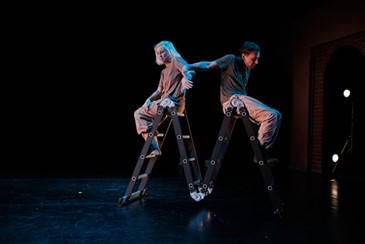
Broadway, where creativity and innovation thrive under the spotlight, has always been a stage for breaking boundaries. In the world of glittering marquees and lavish productions, In Transit arrived like a quiet revolution in 2016, shaking the very foundations of what audiences thought Broadway could be. Unlike the roaring orchestras that typically accompany musicals, this production dared to strip everything down to its core — pure human voice. In Transit was more than just a musical; it was a symphony of voices, with stars like James Snyder breathing life into a capella storytelling. James Snyder Broadway fans knew him for powerful roles, but this was a different challenge. And what a challenge it was.
Redefining the Soundscape of Broadway
Imagine sitting in a Broadway theater, expecting the curtain to rise on the familiar sounds of violins and brass instruments, only to be enveloped in the harmony of human voices. That’s what In Transit dared to do. Instead of relying on a sprawling orchestra, the show presented its characters’ inner lives through nothing but vocal arrangements. Every footstep, every subway screech, every musical swell came not from a pit of musicians, but from the cast’s own vocal cords. This wasn’t just a performance; it was a reimagining of sound, a leap into the unexplored.
The magic behind the music came from a team with credits like Pitch Perfect, who understood the art of a capella in a way few others did. They took beatboxing, vocal percussion, and harmonized melodies and transformed them into a living, breathing soundscape. The performers, including James Snyder, didn’t just sing; they became instruments, fusing sound and story with such precision that it was easy to forget there wasn’t an orchestra backing them up. It was experimental. It was risky. And it was absolutely mesmerizing.
The Story Beneath the Music
But beyond the groundbreaking music lay a narrative that hit home for many. In Transit wasn’t just an experiment in sound; it was an emotional odyssey through the tangled lives of New Yorkers. Each character, caught at a crossroads of life, love, and career, was woven into the vast network of the city’s subway system. It’s a familiar story for anyone who’s felt the chaotic pulse of urban life, where moments of connection happen in the most unexpected places — like a crowded subway platform.
The subway, with its tangled tracks and endless possibilities, became the perfect metaphor for life itself. People meet, pass, collide, and move on, each searching for something meaningful, each at a different stop on their journey. The a capella format only heightened the intimacy of this story, pulling the audience closer to the raw, unfiltered voices that echoed their own experiences. With no instruments to hide behind, the performers — and their stories — were exposed, vulnerable, and real.
Shaking Up Broadway’s Comfort Zone
Broadway is known for its big productions, where sweeping musical scores and elaborate sets dazzle audiences night after night. So when In Transit arrived with nothing but the human voice to carry its weight, it was as much a shock as it was a refreshing change. This wasn’t just another musical; it was a bold experiment in how stories could be told.
Audiences were intrigued, some curious to see how a full-length Broadway show could survive without the usual grand orchestration. The result? For many, it was a revelation. The harmonies created by the cast were nothing short of breathtaking, pushing the boundaries of what could be achieved through a capella. Every sound, every rhythm was deliberate, finely tuned to evoke the emotions at the heart of each scene.
Yet, not everyone was prepared for this departure from tradition. Some theatergoers, used to the lush instrumentals of classics like Phantom of the Opera or Les Misérables, found the absence of an orchestra jarring. But that discomfort was part of the beauty of In Transit. It didn’t play it safe. It asked its audience to listen differently, to hear the story in a new way, and for those willing to take the ride, it was unforgettable.
James Snyder’s Role in the Revolution
At the heart of In Transit was a cast of talented performers, none more pivotal than James Snyder. Known for his strong, emotive performances in shows like Harry Potter and the Cursed Child, Snyder’s versatility as a performer took center stage here. His ability to navigate the vocal demands of a capella performance while delivering the emotional depth of his character was a testament to his range.
For Snyder, In Transit represented a new frontier. It wasn’t just about singing a song; it was about becoming the music, integrating voice and character in a way that few Broadway performers ever had to before. This role pushed him — and the entire cast — to go beyond their comfort zones, to take on the dual responsibility of being both the orchestra and the actor. And for an audience familiar with his previous work, seeing Snyder in this role was a revelation.
The Legacy of In Transit: A Bold Experiment
Though its run on Broadway was brief, In Transit left an indelible mark on the theater world. It wasn’t just a show; it was a statement, a declaration that Broadway could still surprise, still innovate. The boldness of its a capella format opened doors to new possibilities for musical theater. It proved that a Broadway musical didn’t need a 20-piece orchestra or a lavish set to create something powerful and moving. Sometimes, all you need are voices.
The legacy of In Transit lives on, not just in its unique approach to sound but in the way it challenged audiences to think differently about what a Broadway show could be. It was an experiment, yes, but it was also a triumph, proving that even in the well-established world of Broadway, there is still room for invention, for risk, and for magic created from the simplest of ingredients — the human voice.
A Musical Revolution
In Transit may have come and gone quickly from the Broadway stage, but its impact continues to echo. By daring to challenge the status quo, by putting the power of human voice above all else, it reminded us that the magic of Broadway doesn’t come from the grandeur of an orchestra, but from the creativity and passion of its performers. James Snyder and the entire cast of In Transit pushed the limits of what Broadway could be, and in doing so, left behind a legacy of bold, innovative storytelling.





